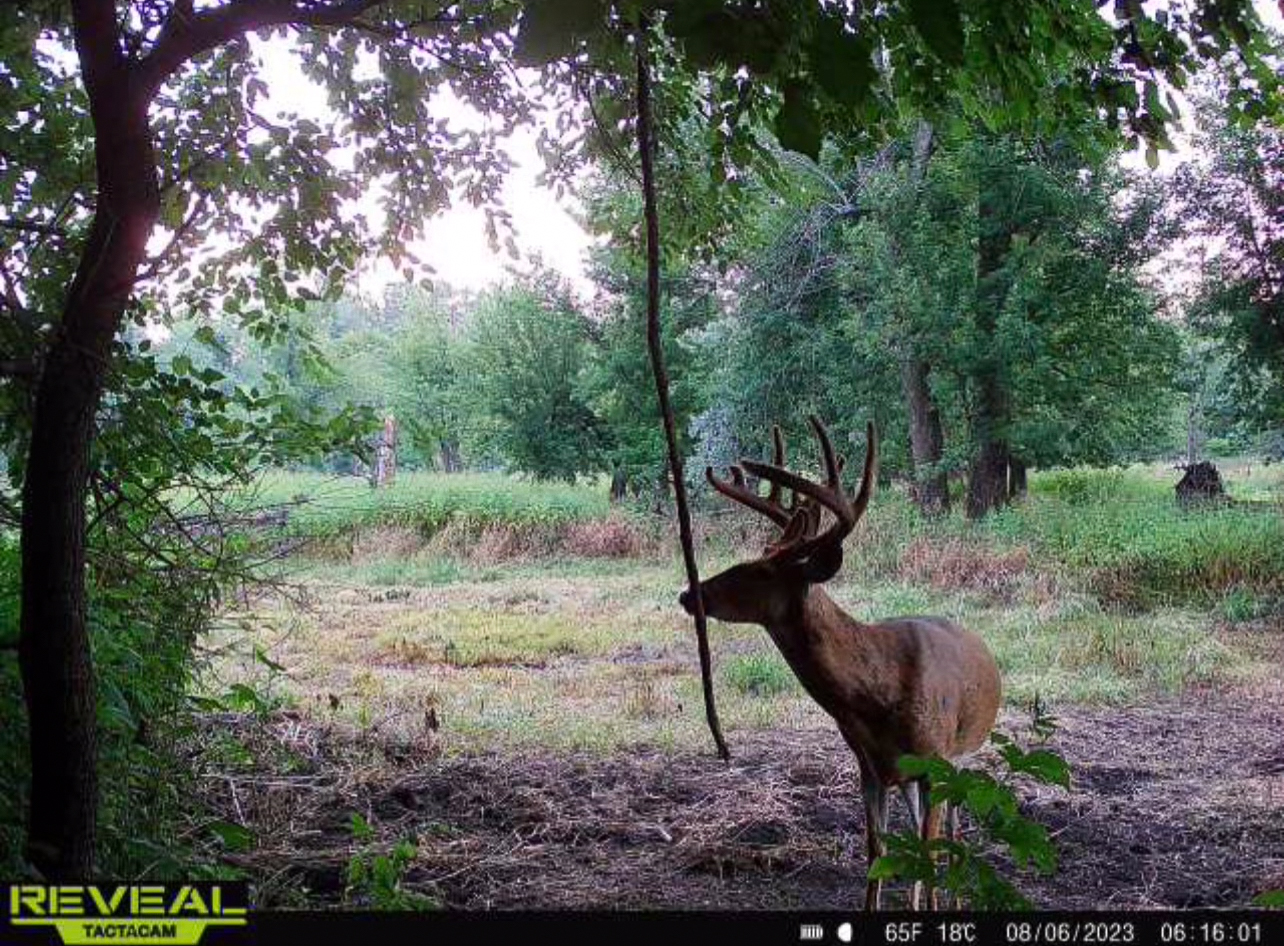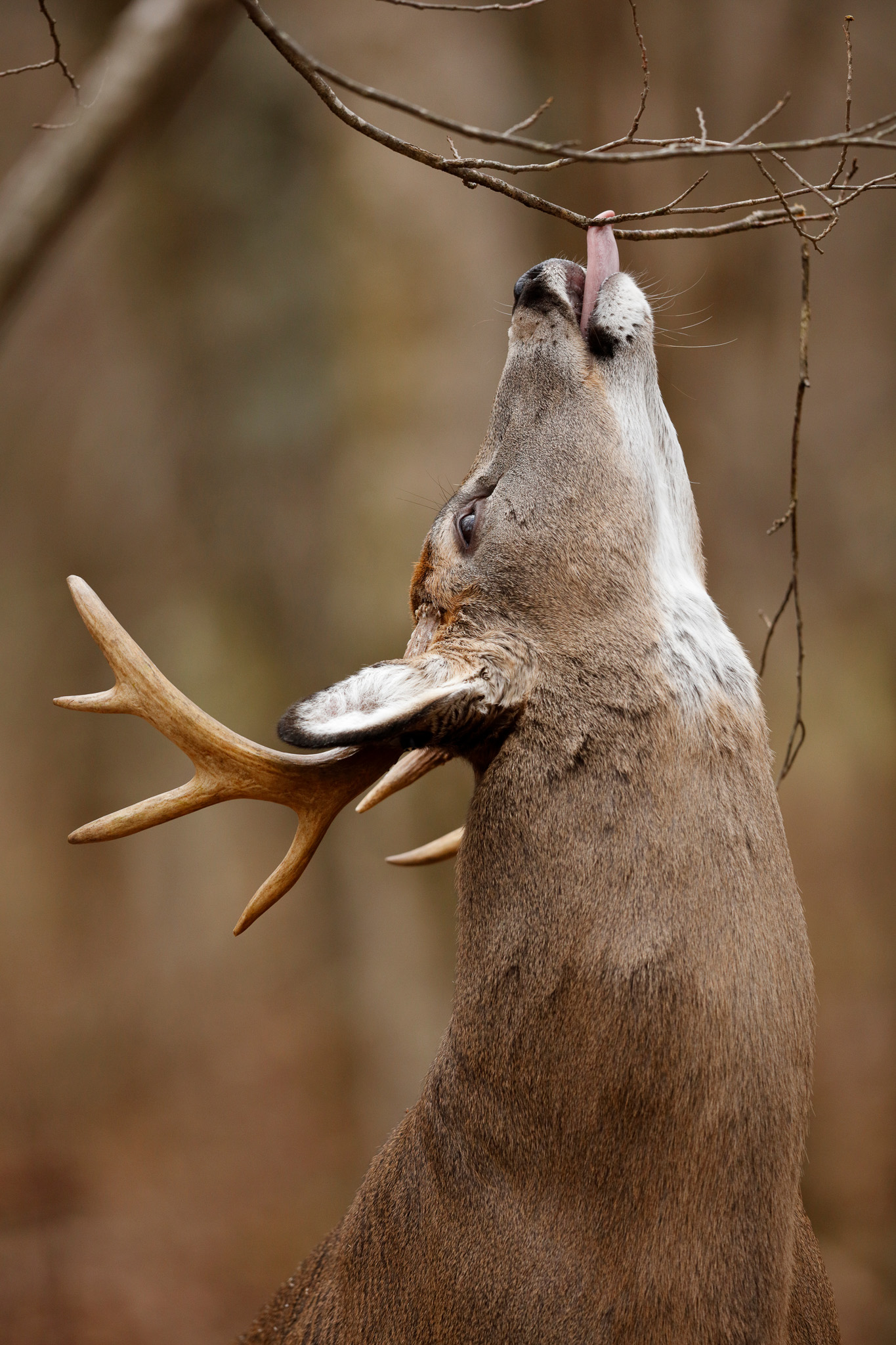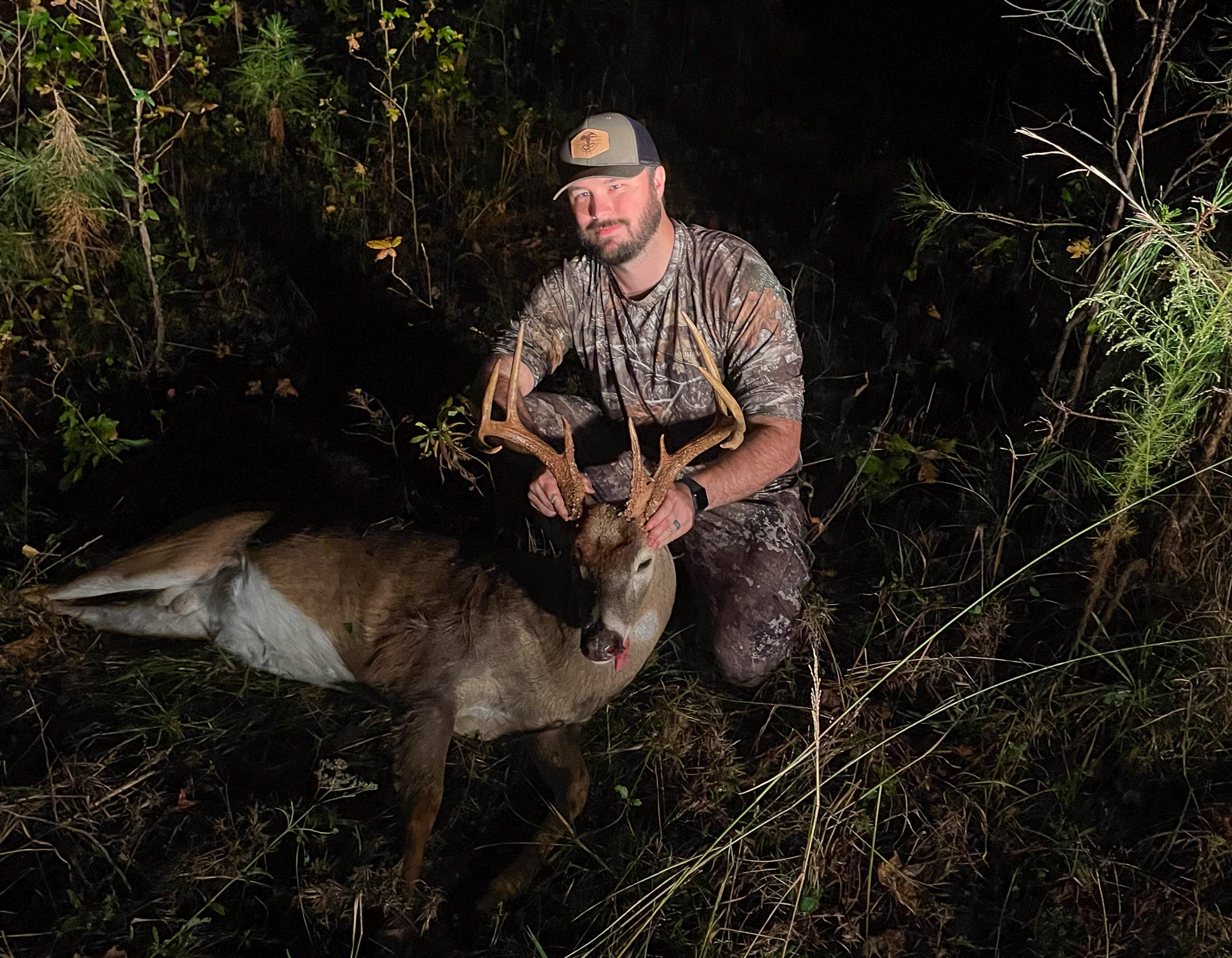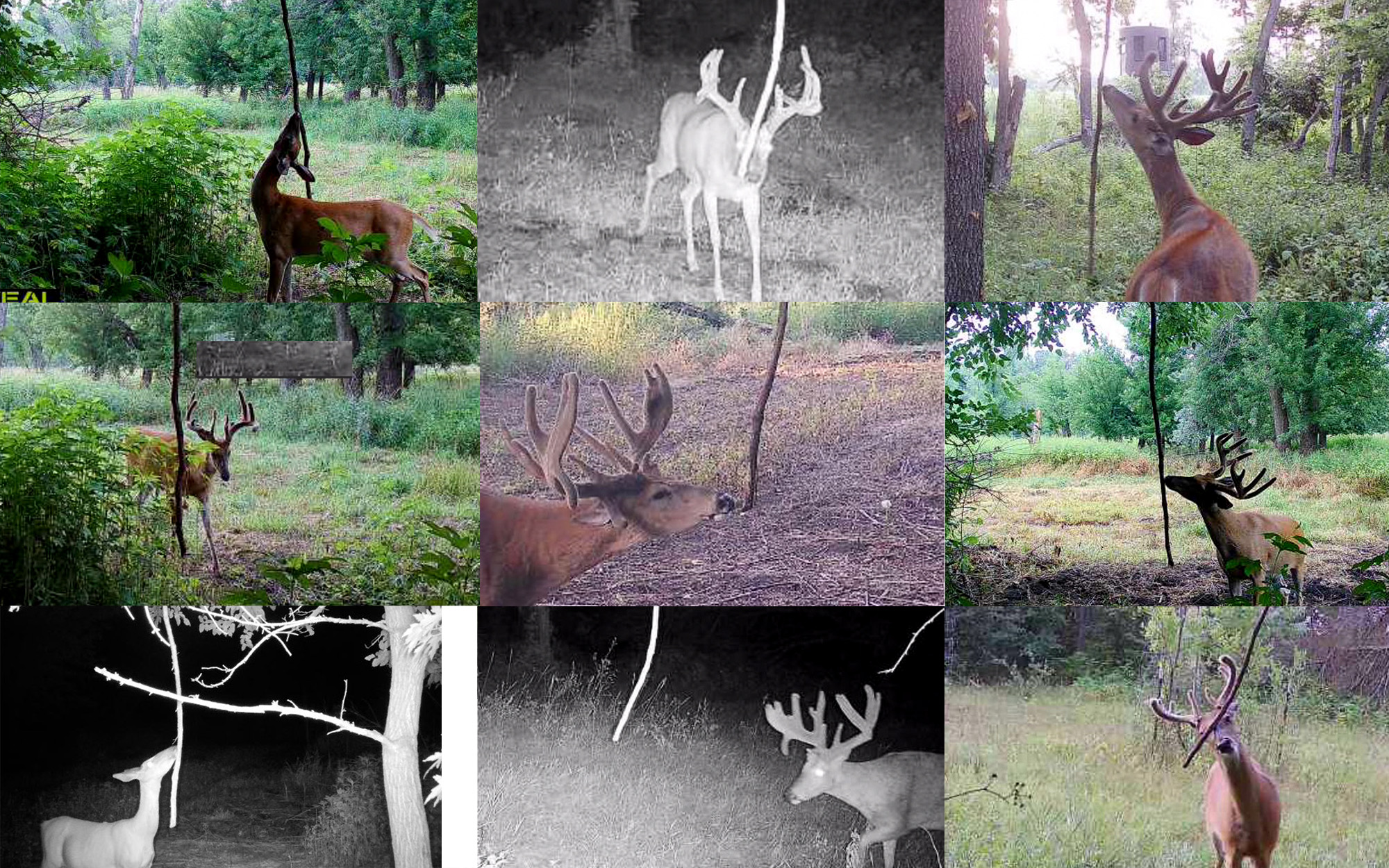Imagine you’ve got two deer properties. Each has a mock scrape on it, which looks like most scrapes — except for one small difference. Instead of carefully breaking branches to create a licking branch, you hung a rope above each scrape. It dangles freely at the same height and position as a normal licking branch.
You’ve also placed cameras at each scrape and discovered that a bunch of does and bucks are visiting the first one. Photos from the second scrape are even better: There’s a good shooter buck regularly hitting the scrape. The problem is, it’s always at night. (This is common: Research shows about 85 percent of bucks and 75 percent of does visit scrapes after dark.) You’ve tried to catch the buck traveling to his bed in the morning and going to feed at night, but you just can’t connect. Finally, you decide to try something radical. You swap the ropes from the two scrapes.
When your target buck next visits the scrape, well, he’s pissed. He smells new deer in his territory — new does, unfamiliar bucks — and he hangs around until daylight, waiting to see who all these new deer are. And that’s when you’re finally able to kill him.
This is a true story of a hunt that actually happened. It illustrates how creating rope scrapes can be simple to create, yet deadly effective. Most serious deer hunters are familiar with mock scrapes. Fewer are familiar with rope scrapes, and fewer still actually use them. The deer hunters we spoke with are relatively new adopters of the setup, but they’re convinced the rope results in more deer visits, more trail cam photos, and more opportunity during hunting season.
Rope Scrapes and Deer Scent
“That’s a cool story. Of course, we’ll never know if [ switching out the ropes is] actually what brought the buck in during daylight hours,” says Brian Grossman, a wildlife biologist by training and the director of communications for the National Deer Association. “Biologically it does make sense in that these deer are leaving different scent cues on that rope or overhanging branch. And I do think those deer can tell what other deer are around. Like us in our neighborhood, we know who lives there by recognizing the individuals.”
Here’s a quick refresher on deer biology: Scrapes are one of the many ways whitetails communicate with each other, says Grossman. Scrapes are essentially the social media of the deer world.
“Deer leave scent in various ways, whether it’s from urinating in the scrape, rubbing their preorbital glands and forehead glands on the licking branches over the scrapes,” says Grossman. “It’s somewhat speculation, but we can assume deer can identify one another through those markers, and know what deer were in that area and when.”
Although Grossman doesn’t personally use ropes in his mock scrapes, he’s noticed a small but growing group of hunters beginning to use them in the last few years.
“Deer are just looking for some type of overhanging visual cue,” says Grossman. “I guess they don’t really care if it’s a branch [or a rope], just that it’s something they can rub their face on and, in a buck’s case, mess around with their antlers.”
Even though bare dirt is what makes a scrape instantly recognizable to us hunters, the licking branch is the more important feature for deer.
“The licking branch is actually used more than the scrape itself,” says Grossman, citing research out of Mississippi State University. “Not every deer would paw out the dirt or urinate in the scrape, but they would all come up and work that licking branch.”

Grossman’s buddy Robert Nelson has been making mock scrapes for years, which he uses in conjunction with trail cameras to inventory deer on the public land he hunts in Georgia. Two seasons ago, Nelson started adding ropes to his mock scrapes instead of relying on natural licking branches.
“I use them mainly on public as a way to create something the deer can key in on and maybe they haven’t seen before,” says Nelson. “The deer use the rope just like a licking branch and they use it all year. They may not work the ground, especially in the summer, but I’ll have does and bucks in velvet check that rope.”
Using ropes allows for more flexibility when choosing ideal locations for mock scrapes.
“I may think it’s a perfect place for a scrape but there are no limbs there for the deer to work as licking branches. So the rope makes it easy for me to make a scrape even if the limbs are too high or aren’t ideal,” says Nelson. “I would [also] say the rope gets a little more activity. Because I’ve tried to go in and create a licking branch scenario where I’ve got a really big oak limb, and I try to break some limbs so they hang down. I try to make it look as natural as I can. And I’ve had a bunch of those fail. I don’t know if it was something I was doing, if I didn’t make it look as natural as it needed to look. Because I know lots of hunters do that and have a lot of success with that. But I’ve just found using the ropes that I’ve had a lot more success in getting deer to key in on a mock scrape.”
Nelson currently has 10 established rope scrapes and plans to create a handful more this season. Deer consistently visit five of those, while the other five are hit and miss. If deer don’t consistently use one of his rope scrapes, he removes the rope and establishes it at a new location. Sometimes, he’ll shovel dirt from a well-used mock scrape and introduce it to another.
So far, Nelson has taken two nice public-land bucks off rope scrapes. He helped a buddy shoot his first deer with a bow over one two months before the rut kicked in, then killed a 9-point himself closer to the rut.
Why Are Rope Scrapes So Effective?
Chuck Grado, who hunts giant bucks with his wife in Iowa, noticed rope scrapes somewhere on the internet last year and adapted the concept across his 370-acre property. Instead of buying manmade ropes, however, he opts for a natural version.
“I thought about the ropes and then I thought, What’s more natural than a grapevine?” says Grado, who works with a DNR-certified forester to manage his hunting property. “We’re supposed to cut those vines down anyway because they’re hard on our trees, so now we have a use for them.”
Grado is an instant convert.
“I tried making mock scrapes for several years,” says Grado. “Sometimes I’d break a branch too much while creating a licking branch. It ended up getting shredded [by deer] and the site was abandoned. The grapevine has been a ninety-five percent success, if not a hundred percent success.”
By that, Grado means more deer are consistently visiting his mock scrapes now that he’s installing vines for licking branches.

With little research on how deer use scrapes (and nothing we could find that mentions rope scrapes), hunters are left to speculate what makes ropes (and vines), at least anecdotally, more attractive to deer than traditional licking branches. We know deer rely on their noses, and presumably their memories, when they visit scrapes.
Both Nelson and Grado say their upgraded licking branches seem to catch a deer’s eye. You’ll notice the effect yourself if you’re ever scouting or walking a property with rope scrapes: The dangling rope is much easier to pick out of a treeline than a natural licking branch against a jumbled backdrop of other branches. Instead of keeping a careful eye out for sign, you can’t help but spot the ropes.
It also stands to reason that a rope holds scent longer than a licking branch, and may therefore be attractive to more deer in the area or more deer over time.
“I would say the fabric is going to hold scent better than a hard oak limb,” says Nelson, who uses ordinary woven rope about an inch in diameter. “The limb may hold scent, but the fabric is going to absorb it better in my opinion. It’s like your clothes: Leather boots are going to hold scent more than rubber boots.”
Well-secured ropes and vines also make more permanent licking branches that require less maintenance and result in established scrapes over time. Nelson discovered a natural scrape on a piece of public ground five years ago that deer would’ve ceased using if he hadn’t modified it.
“The tree has grown since then so the limbs got too high off the ground and the deer really couldn’t work it. Being able to put the rope on the limb, and get it to hang down where I needed it to, allowed the deer to continue to use that scrape.”
While rope scrapes aren’t exactly new, they’re far from mainstream. Grado says he texted vine-scrape trail cam photos to a dozen hunting buddies and learned just two were using rope scrapes. After seeing Grado’s success, however, the other 10 have started incorporating ropes into their mock scrapes.
How to Make a Rope Scrape
To make a rope scrape, follow the standard procedure for making a mock scrape, with the following adjustments.
Choose the Right Rope
The material you choose for your rope scrapes can vary: You can use natural vines, hemp, or store-bought rope as long as it’s a woven fabric; avoid synthetic or plastic ropes since they likely won’t hold scent as well. In fact, if you choose to use a rope, let it sit out in the elements for a few days so that it doesn’t smell like the store you bought it from or the packaging it came in.
Hang It Carefully
“I’m six foot one, and I try to hang it down from the limb to about my belly button,” says Nelson. “That way it’s hanging down far enough that deer can basically walk right into it and rub on it or scent check it with their nose. It’s not too high so they have to stand up on their back feet.”
Sometimes Nelson can tie the rope to an accessible branch; other times he’ll throw it over a limb and secure it. (The length of the rope will depend on the height of the branch you want to hang it from.) He’s meticulous about scent control while making scrapes and handling the ropes, and recommends wearing rubber gloves and rubber boots when setting scrapes.
Grado is less fastidious, preferring to wear regular work gloves. To reach overhanging branches he parks his UTV under the tree and stands in the bed, then ties 6-foot grapevines to tree limbs using small pieces of paracord. The best grapevines are straight (the crooked ones spin and flop around too much when deer work them) and hang about 4 feet off the ground.
Make Rope Scrapes in the Off Season
Establish new rope scrapes sites as early as you can to let deer become familiar with them before the hunting season starts. Spring and summer are ideal.
Pick the Right Location
Ropes are effective, but they aren’t magic. Nelson recommends choosing your scrape sites carefully. For the best results, identify locations along travel routes, pinch points, funnels, and feeding and bedding areas. He rarely freshens his scrapes, choosing instead to check on the productive ones about once a year to scuff the ground, urinate in the fresh dirt, and check cameras. Usually the rope is the one thing he doesn’t have to adjust.
Hunting Over Rope Scrapes

Like Nelson, Grado uses trail cameras over scrapes to inventory the local deer population and study mature bucks, but he also incorporates scrapes directly into his stand setups.
“I hung a vine up next to every stand I own,” says Grado, who has 24 tree stands on his Iowa property, which is primarily timber with 20 acres of corn and 12 acres of food plots. “They’re [about] 20 yards from each stand. It gives deer something to focus on. The deer will go over to check it out instead of wandering down the trail or looking in my direction. Then they work the vine for maybe 60 seconds or so, and they turn and give you different angles [to evaluate a buck] and give you a chance to draw your bow.”
For his part Grado hasn’t tried swapping ropes, but he has heard of hunters removing part of a natural licking branch from a scrape and zip tying it to another licking branch to introduce additional deer scent to an area. With two dozen rope scrapes attracting and distracting deer all across his property, Grado says it’s one more thing that could help delay them from leaving your hunting area. In other words, each minute a promising 2.5-year-old buck spends at your scrapes could make the difference between a neighbor shooting a buck you planned to pass and the end of legal light.
Read Next: The Best Trail Cameras, Tested and Reviewed
Although Grado didn’t shoot a deer this season (he was holding out for a 210-class buck that another hunter ended up killing), his wife, Ruth Macke, tagged two mature does in one sit. One doe had just finished working the vine hanging near her stand; the second was headed purposefully to the scrape.
Read the full article here




